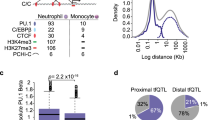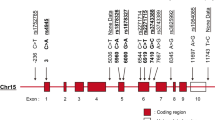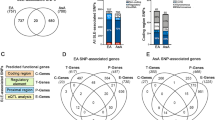Abstract
G Protein Signaling Modulator-3 (GPSM3) is a leukocyte-specific regulator of G protein-coupled receptors (GPCRs), which binds inactivated Gαi·GDP subunits and precludes their reassociation with Gβγ subunits. GPSM3 deficiency protects mice from inflammatory arthritis and, in humans, GPSM3 single-nucleotide polymorphisms (SNPs) are inversely associated with the risk of rheumatoid arthritis development; recently, these polymorphisms were linked to one particular SNP (rs204989) that decreases GPSM3 transcript abundance. However, the precise role of GPSM3 in leukocyte biology is unknown. Here, we show that GPSM3 is induced in the human promyelocytic leukemia NB4 cell line following retinoic acid treatment, which differentiates this cell line into a model of neutrophil physiology (NB4*). Reducing GPSM3 expression in NB4* cells, akin to the effect ascribed to the rs204989 C>T transition, disrupts cellular migration toward leukotriene B4 (LTB4) and (to a lesser extent) interleukin-8 (a.k.a. IL-8 or CXCL8), but not migration toward formylated peptides (fMLP). As the chemoattractants LTB4 and CXCL8 are involved in recruitment of neutrophils to the arthritic joint, our results suggest that the arthritis-protective GPSM3 SNP rs204989 may act to decrease neutrophil chemoattractant responsiveness.
This is a preview of subscription content, access via your institution
Access options
Subscribe to this journal
Receive 6 digital issues and online access to articles
$119.00 per year
only $19.83 per issue
Buy this article
- Purchase on Springer Link
- Instant access to full article PDF
Prices may be subject to local taxes which are calculated during checkout



Similar content being viewed by others
Accession codes
References
Willard FS, Kimple RJ, Siderovski DP . Return of the GDI: the GoLoco motif in cell division. Annu Rev Biochem 2004; 73: 925–951.
Billard MJ, Gall BJ, Richards KL, Siderovski DP, Tarrant TK . G protein signaling modulator-3: a leukocyte regulator of inflammation in health and disease. Am J Clin Exp Immunol 2014; 3: 97–106.
Fairfax BP, Humburg P, Makino S, Naranbhai V, Wong D, Lau E et al. Innate immune activity conditions the effect of regulatory variants upon monocyte gene expression. Science 2014; 343: 1246949.
Naranbhai V, Fairfax BP, Makino S, Humburg P, Wong D, Ng E et al. Genomic modulators of gene expression in human neutrophils. Nat Commun 2015; 6: 7545.
Sirota M, Schaub MA, Batzoglou S, Robinson WH, Butte AJ . Autoimmune disease classification by inverse association with SNP alleles. PLoS Genet 2009; 5: e1000792.
Corona E, Dudley JT, Butte AJ . Extreme evolutionary disparities seen in positive selection across seven complex diseases. PLoS One 2010; 5: e12236.
Plenge RM, Seielstad M, Padyukov L, Lee AT, Remmers EF, Ding B et al. TRAF1-C5 as a risk locus for rheumatoid arthritis—a genomewide study. N Engl J Med 2007; 357: 1199–1209.
Hom G, Graham RR, Modrek B, Taylor KE, Ortmann W, Garnier S et al. Association of systemic lupus erythematosus with C8orf13-BLK and ITGAM-ITGAX. N Engl J Med 2008; 358: 900–909.
Hirota T, Takahashi A, Kubo M, Tsunoda T, Tomita K, Sakashita M et al. Genome-wide association study identifies eight new susceptibility loci for atopic dermatitis in the Japanese population. Nat Genet 2012; 44: 1222–1226.
Li L, Kabesch M, Bouzigon E, Demenais F, Farrall M, Moffatt MF et al. Using eQTL weights to improve power for genome-wide association studies: a genetic study of childhood asthma. Front Genet 2013; 4: 103.
Gall BJ, Wilson A, Schroer AB, Gross JD, Stoilov P, Setola V et al. Genetic variations in GPSM3 associated with protection from rheumatoid arthritis affect its transcript abundance. Genes Immun 2016; 17: 139–147.
Giguere PM, Billard MJ, Laroche G, Buckley BK, Timoshchenko RG, McGinnis MW et al. G-protein signaling modulator-3, a gene linked to autoimmune diseases, regulates monocyte function and its deficiency protects from inflammatory arthritis. Mol Immunol 2013; 54: 193–198.
Wright HL, Moots RJ, Edwards SW . The multifactorial role of neutrophils in rheumatoid arthritis. Nat Rev Rheumatol 2014; 10: 593–601.
Sadik CD, Kim ND . Luster AD. Neutrophils cascading their way to inflammation. Trends Immunol 2011; 32: 452–460.
Parham P . The Immune System, 3rd edn. Garland Science: New York, NY, USA, 2009.
Jacobs JP, Ortiz-Lopez A, Campbell JJ, Gerard CJ, Mathis D, Benoist C . Deficiency of CXCR2, but not other chemokine receptors, attenuates autoantibody-mediated arthritis in a murine model. Arthritis Rheum 2010; 62: 1921–1932.
Seeling M, Hillenhoff U, David JP, Schett G, Tuckermann J, Lux et al. Inflammatory monocytes and Fcgamma receptor IV on osteoclasts are critical for bone destruction during inflammatory arthritis in mice. Proc Natl Acad Sci USA 2013; 110: 10729–10734.
Shao WH, Del Prete A, Bock CB, Haribabu B . Targeted disruption of leukotriene B4 receptors BLT1 and BLT2: a critical role for BLT1 in collagen-induced arthritis in mice. J Immunol 2006; 176: 6254–6261.
Griffiths RJ, Smith MA, Roach ML, Stock JL, Stam EJ, Milici AJ et al. Collagen-induced arthritis is reduced in 5-lipoxygenase-activating protein-deficient mice. J Exp Med 1997; 185: 1123–1129.
Chen M, Lam BK, Kanaoka Y, Nigrovic PA, Audoly LP, Austen KF et al. Neutrophil-derived leukotriene B4 is required for inflammatory arthritis. J Exp Med 2006; 203: 837–842.
Berger M, Budhu S, Lu E, Li Y, Loike D, Silverstein SC et al. Different G(i)-coupled chemoattractant receptors signal qualitatively different functions in human neutrophils. J Leukoc Biol 2002; 71: 798–806.
Neptune ER, Iiri T, Bourne HR . Galphai is not required for chemotaxis mediated by Gi-coupled receptors. J Biol Chem 1999; 274: 2824–2828.
Neptune ER, Bourne HR . Receptors induce chemotaxis by releasing the betagamma subunit of Gi, not by activating Gq or Gs. Proc Natl Acad Sci USA 1997; 94: 14489–14494.
Csomos K, Nemet I, Fesus L, Balajthy Z . Tissue transglutaminase contributes to the all-trans-retinoic acid-induced differentiation syndrome phenotype in the NB4 model of acute promyelocytic leukemia. Blood 2010; 116: 3933–3943.
Giguere PM, Laroche G, Oestreich EA, Siderovski DP . G-protein signaling modulator-3 regulates heterotrimeric G-protein dynamics through dual association with Gbeta and Galphai protein subunits. J Biol Chem 2012; 287: 4863–4874.
Kimple RJ, Willard FS, Hains MD, Jones MB, Nweke GK, Siderovski DP . Guanine nucleotide dissociation inhibitor activity of the triple GoLoco motif protein G18: alanine-to-aspartate mutation restores function to an inactive second GoLoco motif. Biochem J 2004; 378: 801–808.
Nebl T, Pestonjamasp KN, Leszyk JD, Crowley JL, Oh SW, Luna EJ . Proteomic analysis of a detergent-resistant membrane skeleton from neutrophil plasma membranes. J Biol Chem 2002; 277: 43399–43409.
Hrdlickova B, Kumar V, Kanduri K, Zhernakova DV, Tripathi S, Karjalainen J et al. Expression profiles of long non-coding RNAs located in autoimmune disease-associated regions reveal immune cell-type specificity. Genome Med 2014; 6: 88.
Klickstein LB, Shapleigh C, Goetzl EJ . Lipoxygenation of arachidonic acid as a source of polymorphonuclear leukocyte chemotactic factors in synovial fluid and tissue in rheumatoid arthritis and spondyloarthritis. J Clin Invest 1980; 66: 1166–1170.
Dorward DA, Lucas CD, Chapman GB, Haslett C, Dhaliwal K, Rossi AG . The role of formylated peptides and formyl peptide receptor 1 in governing neutrophil function during acute inflammation. Am J Pathol 2015; 185: 1172–1184.
Mullmann TJ, Cheewatrakoolpong B, Anthes JC, Siegel MI, Egan RW, Billah MM, Phospholipase C . and phospholipase D are activated independently of each other in chemotactic peptide-stimulated human neutrophils. J Leukoc Biol 1993; 53: 630–635.
Robichaux WG 3rd, Oner SS, Lanier SM, Blumer JB . Direct coupling of a seven-transmembrane-span receptor to a Galphai G-Protein regulatory motif complex. Mol Pharmacol 2015; 88: 231–237.
O'Doherty U, Swiggard WJ, Malim MH . Human immunodeficiency virus type 1 spinoculation enhances infection through virus binding. J Virol 2000; 74: 10074–10080.
Idres N, Benoit G, Flexor MA, Lanotte M, Chabot GG . Granulocytic differentiation of human NB4 promyelocytic leukemia cells induced by all-trans retinoic acid metabolites. Cancer Res 2001; 61: 700–705.
Livak KJ, Schmittgen TD . Analysis of relative gene expression data using real-time quantitative PCR and the 2(-Delta Delta C(T)) Method. Methods 2001; 25: 402–408.
Acknowledgements
We thank Dr Sherman Weissman for his generous gift of the NB4 cell line at the onset of these studies. This work was supported in part by the National Institutes of Health under Award Number U54GM104942.
Author information
Authors and Affiliations
Corresponding author
Ethics declarations
Competing interests
The authors declare no conflict of interest.
Additional information
Supplementary Information accompanies this paper on Genes and Immunity website
Supplementary information
Rights and permissions
About this article
Cite this article
Gall, B., Schroer, A., Gross, J. et al. Reduction of GPSM3 expression akin to the arthritis-protective SNP rs204989 differentially affects migration in a neutrophil model. Genes Immun 17, 321–327 (2016). https://doi.org/10.1038/gene.2016.26
Received:
Revised:
Accepted:
Published:
Issue Date:
DOI: https://doi.org/10.1038/gene.2016.26



